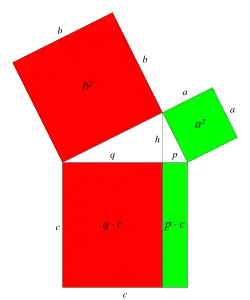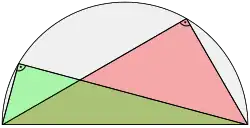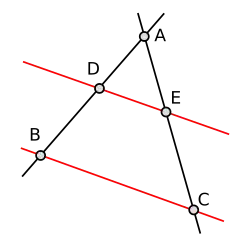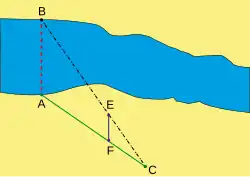Linear algebra (Osnabrück 2024-2025)/Part II/Lecture 36
- Triangles
In this and the next lecture, we are dealing with triangles. A triangle is just a tuple of three points (called vertices) in an affine space (typically, an affine plane) over a Euclidean space . We allow the situation that some or all vertices coincide (a degenerate triangle), and we identify triangles if they only differ by the ordering of the vertices. A triangle is by definition not degenerate if and only if the three points are affinely independent. Quite often, we regard a triangle as its convex hull, that is, the set
of all barycentric combinations of the three points, where all coefficients are not negative. The connecting segment
is called the edge between the vertices and (or the edge opposite of ). It is often denoted by , its length is
The corresponding denominations hold for the other edges. Sometimes we also denote the lengths of the edges by . The angle of the triangle at the vertex is defined as
accordingly for the other vertices. The angles are usually denoted by .
Two triangles in a Euclidean plane are called congruent if they can be transformed into each other by the composition of a translation and an
isometry.We also say that congruent triangles can be transformed into each other by an affine-linear isometry.
Two triangles in a Euclidean plane are congruent
to each other if and only if their edge lengths coincide.Translations and isometries preserve lengths; therefore, congruent triangles have the same lengths of edges. Let now two triangles and be given, having the same edge lengths. After renaming, we may assume that the edge lengths fulfill the relation
and that the same holds for the second triangle. We can assume , and we can also assume after a translation that holds. After rotations of the triangles around the origin, we may further assume that as well as lie on the positive -axis. Because of the length equality, we have . The points and have, on one hand, the same distance to , and, on the other hand, the same distance to . That is, they lie on the intersection of a circle about and a circle about . Since there are only two intersection points, we have either , or and can be transformed to each other by a reflection at the -axis.
Two triangles in a Euclidean plane are called properly congruent if they can be transformed into each other by the composition of a translation and a
proper isometry.Two triangles in a Euclidean plane are called similar if they can be transformed into each other by the composition of a translation and an
angle-preserving mapping.Two triangles in a Euclidean plane are similar
to each other if and only if their angles coincide.Proof
- The Pythagorean theorem
A triangle is called a right triangle if for one vertex the adjacent edges are perpendicular
to each other.In a right triangle, the side opposite to the right angle is called the hypotenuse
of the right triangle.In a right triangle, the sides adjacent to the right angle are called the catheti (or legs)
of the right triangle.The Pythagorean theorem for a right triangle says the following.
In a right triangle, the area of the square of the hypotenuse
equals the sum of the areas of the squares of the two other sides.We denote the vertices of the triangle by , with the right angle located at . We set , and . The vector from to equals , and and are perpendicular to each other. Therefore,
In this formulation, we use that the area of a square
(that is, of the geometric object)
equals the
(arithmetic)
square of the side lengths. The proof does not refer to areas.
For a triangle in a Euclidean plane, the line running through and being perpendicular to the line given by and , is called the altitude line through . The line segment from to the line given by and is called the altitude
through .The length of the altitude is also called the altitude.
In a triangle in a Euclidean plane, the intersecting point of the altitude line through with the line given by and is called the foot
of this altitude.
Der following theorem is called the Cathetus theorem.
Let be a right triangle, with the right angle located at . Let denote the altitude through , and let denote the foot of this altitude on the line given by and . Then
We set , and . The vector from to equals . Due to Lemma 32.14 , the foot of the altitude is
Hence, we obtain
The following theorem is called the Right triangle altitude theorem.
Let be a right triangle, with the right angle located at . Let be the altitude through , and let denote the foot of this altitude through the linen given by and . Then
Proof
The following theorem is called the Law of cosines.
Proof
- Thales's theorem

Let be a point in the Euclidean plane , let be a circle with center , and let be a line through , intersecting the circle in the points and . Then for every point ,
the triangle is a right triangle with the right angle at .Without loss of generality, we may assume that and ; we denote the radius by . We write , , . The vector from to is , and the vector from to is . Therefore,
This means that the two sides of the triangle meeting at are perpendicular to each other.
- The intercept theorems
We formulate in the language of linear algebra the intercept theorems. We work in the setting of a two-dimensional Euclidean vector space, which provides lengths of line segments. Two affine lines are called parallel if they are spanned by the same vector. We formulate the intercept theorems in such a way that the intersecting point of the rays lies in the origin. This can always be achieved by translating the intersecting point to the origin, as this does not change the lengths.

Let denote a two-dimensional Euclidean vector space, let be vectors, and suppose that and are linearly independent, and that and are linearly independent. Let and denote the lines (the rays) defined by and . Let and be points in with the corresponding parallel lines and . We denote the intersecting points (which exist uniquely due to the condition) by
and suppose that . Then
Without loss of generality, we may assume that , , and , as this does not change the lines involved. We write . We have ; therefore, we obtain
This point belongs to and also to . This means that this point is just . Hence, , and
In particular, the preceding theorem says that in the given situation, the ratios of corresponding side lengths of the triangles
and
are the same. These triangles are similar; the triangle arises from the triangle by a homothety with factor . This factor describes all length relations.


Let denote a two-dimensional Euclidean vector space, let be vectors, and suppose that and are linearly independent, and that and are linearly independent. Let and denote the lines defined by and . Let and be points in with the corresponding parallel lines and . We denote the intersecting points (which exist uniquely due to the condition) by
and suppose that . Then
This follows directly from Theorem 36.16 .
In particular, we have the equation
which only takes the lengths on the rays into account.

In the last variant of the intercept theorem, there are three rays.
Let be a two-dimensional Euclidean vector space, let be vectors, and suppose that is linearly independent to each of these vectors. Let , , be the lines defined by the . Let and be points in with den corresponding parallel lines and . We denote the intersecting points of the lines (which exist uniquely due to the conditions) by
and suppose that . Then
We apply Corollary 36.17 twice, to the situation given by and to the situation given by , and we obtain
| << | Linear algebra (Osnabrück 2024-2025)/Part II | >> PDF-version of this lecture Exercise sheet for this lecture (PDF) |
|---|